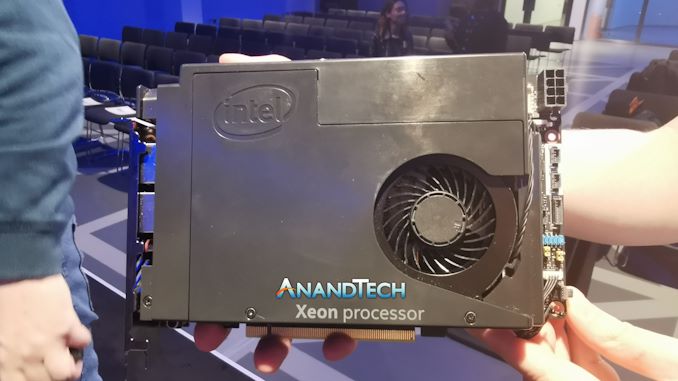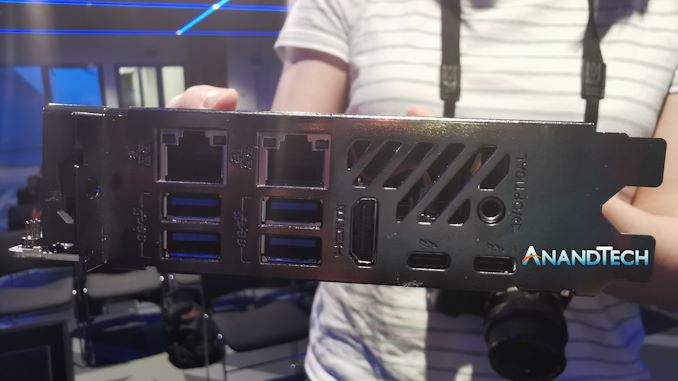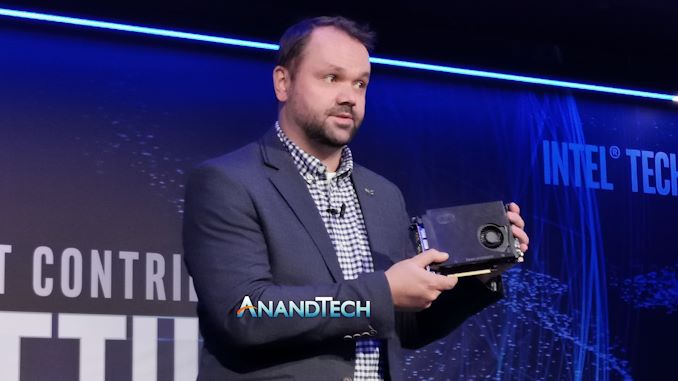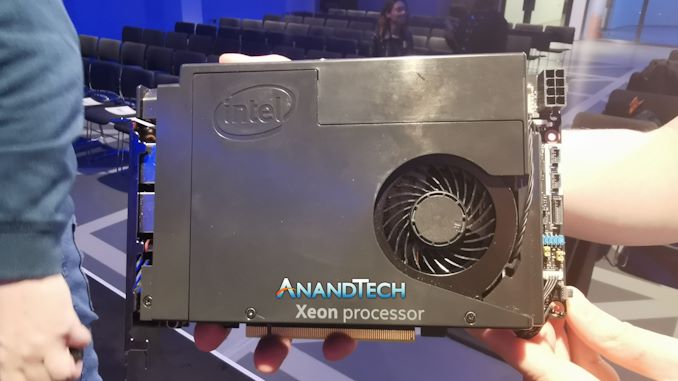The Modular PC: Intel’s new Element brings Project Christine to Life
by Dr. Ian Cutress on October 7, 2019 3:55 PM EST- Posted in
- CPUs
- Intel
- Xeon
- Razer
- NUC
- PCIe
- Compute Element
- Project Christine
- Intel Element

Way back at CES 2014, Razer’s CEO introduced a revolutionary concept design for a PC that had one main backplane and users could insert a CPU, GPU, power supply, storage, and anything else in a modular fashion. Fast forward to 2020, and Intel is aiming to make this idea a reality. Today at a fairly low-key event in London, Intel’s Ed Barkhuysen showcased a new product, known simply as an ‘Element’ – a CPU/DRAM/Storage on a dual-slot PCIe card, with Thunderbolt, Ethernet, Wi-Fi, and USB, designed to slot into a backplane with multiple PCIe slots, and paired with GPUs or other accelerators. Behold, Christine is real, and it’s coming soon.
‘The Element’ from Intel
Truth be told, this new concept device doesn’t really have a name. When specifically asked what we should call this thing, we were told to simply call it ‘The Element’ – a product that acts as an extension of the Compute Element and Next Unit of Computing (NUC) family of devices. In actual fact, ‘The Element’ is a product of the same team inside Intel: the Systems Product Group responsible for the majority of Intel’s small form factor devices has developed this new ‘Element’ in order to break the iterative design cycle into something that is truly revolutionary.
(This is where a cynic might say that Razer got there first… Either way, everyone wins.)
What was presented on stage wasn’t much more than a working prototype of a small dual-slot PCIe card powered by a BGA Xeon processor. On the card was also two M.2 slots, two slots for SO-DIMM LPDDR4 memory, a cooler sufficient for all of that, and then additional controllers for Wi-Fi, two Ethernet ports, four USB ports, a HDMI video output from the Xeon integrated graphics, and two Thunderbolt 3 ports.
The M.2 slots and SO-DIMM slots are end-user accessible, by lifting a couple of screws from the front. This is in no-way a final design, but just a working prototype. The exact cooler, styling, and even the product name is in no way final yet, but the concept is solid.
The product shown used a Xeon BGA processor, however it was clear that this concept can be moved into consumer processors as well. As with the current NUC family, this would likely migrate into the mobile processors rather than BGA versions of desktop processors, and the fact that there are Thunderbolt 3 ports on the side would hint towards 10th Generation Ice Lake, however Intel stated that all options at this design stage are open at this point.
This whole card has a PCIe slot, which we believe at this time to be PCIe 3.0. It stands to reason that if this Element becomes a generational product, then it would migrate to PCIe 4.0 and PCIe 5.0 / CXL as and when Intel moves its product families onto those technologies. Intel is planning to bundle the card to partners with a backplane – a PCB with multiple PCIe slots. One slot would be designated the master host slot, and the CPU/DRAM/Storage combination would go in that slot. Discrete GPUs, professional graphics, FPGAs, or RAID controllers are examples of cards that could fit into the other slots.
In these configurations, in every instance the CPU compute card is the host, rather than an attached device. Intel does offer CPUs-on-a-card-as-a-device, which is Intel’s Visual Compute Accelerator (VCA), which pairs three Xeon E3 CPUs onto a slave card that is accessed from the host. We asked if Intel has plans that its Element cards could be used as a slave card in this configuration, but Intel stated there are no current plans to do so.
The backplane would also be the source of power. A direct PSU into the backplane would serve as offering 75W to each of the PCIe slots, as well as any other features such as system fans or additional on-backplane controllers. This power could come from a PSU, or from a 19V input, depending on the exact configuration of the system. The Element card we saw had an additional 8-pin PCIe power connector, suggesting another 150W could be powered to the card, giving a total of 225W for CPU, DRAM, and storage: which would beg the question if the card could support something like a Core i9-9900KS.
On the topic of cooling, the demo unit shown had very much a basic cooling setup. As stated, Intel said that this is in no-way the final version of what Intel is trying to do here. When asked if it would be easy enough for users to liquid cool the CPU, the Intel spokesperson said it would be customizable, though it would be up to component manufacturers to enable that themselves.
For board partners, Intel stated that they are not seeing this Element form factor as something that partners would create themselves. In essence, there would be no AIB partners like in the GPU market, but for OEMs that to build pre-built systems, they could take the Element card and customize on top of the Intel design, as well as develop their own backplanes and such.
Ultimately with the Element, Intel wants to make it easier for integrated system upgrades. Customers can keep the chassis, keep the system setup, keep the backplane, and all they would do is change the Element card to get the latest performance and features. This was the ultimate goal with something like Razer’s Project Christine, and is certainly something to work towards. However, by keeping the storage on the Element rather than having it as a separate add-in card, this is somewhat limiting as it would require swapping the drives out. This might not be much of an issue, if one of the PCIe slots on the backplane was used for M.2 drives (or even with drives on the backplane itself).
Intel stated that the plan for the Element to see daylight in the hands of OEMs would be sometime in Q1 2020, likely at the back-end of Q1. Our spokesman said that exact CPUs and configurations are still in flux, and as one might expect, so is pricing. Exactly how the Element will be named is a mystery, and how it will be packaged either to end users or OEMs is a question to answer.
Given that this is a product from the same group as the NUC, I highly expect it to follow the same roll-out procedure as other NUC products. Personally, I think this form factor would be great if Intel could standardize it and open it up to motherboard partners. I imagine that we might see some board partners do copy-cat designs, similarly with how we have several variations of NUCs on the market. Intel stated that they have a roadmap for the Element, which is likely to extend over multiple generations. I theorised a triple slot version with an Xe GPU, and the idea wasn't dismissed out of hand immediately.
We asked about RGB LEDs. The question recieved a chuckle, but it is going to be interesting whether Intel limits the Element to a professional environment or opens it up to more run-of-the-mill users.
We’ve politely asked Intel to let us know when it is ready so we can test. Our Intel spokesman was keen to start sampling when it is ready, stating that sampling budget in this context is not a problem. I think we’ll have to hold them to that.
Related Reading
- Intel Launches the NUC Compute Element for Modular Computing Systems
- Intel's Bean Canyon (NUC8i7BEH) Coffee Lake NUC Review - Ticking the Right Boxes
- EGlobal's NUC-Like PC Packs Intel’s Unlocked Hex-Core i7-8750HK CPU
- Shuttle’s X1 Now Available: NUC-Like PC With a GeForce GTX 1060 GPU
- Memory Frequency Scaling on Intel's Skull Canyon NUC - An Investigation















86 Comments
View All Comments
alumine - Monday, October 7, 2019 - link
So, uh, basically similar to industrial PCs (PICMG/COM Express/etc) but in a consumer-friendly form factor...?MamiyaOtaru - Monday, October 7, 2019 - link
interesting from a modularity standpoint, but ugh on giving up on the cooling potential we have with standard motherboards. Imagine going from a tower cooler or water cooler to that fansuperunknown98 - Monday, October 7, 2019 - link
There are just so many things wrong with this. Intel has taken a laptop motherboard and put it on a backplane so users won't have to throw away their computer cases? As mentioned, storage will have to be swapped out and windows/ linux possibly reinstalled with the new element.As for OEM's, how is support going to deal with generations of Elements plugged into a backplane? Will those Elements be vendor agnostic? Could I plug a Dell element into my HP chassis and when something goes wrong who provides the support?
I don't think anyone except enthusiasts and businesses would upgrade their computers in this day and age. Most people have moved on from desktops and are happy with laptops and phones. I don't think you will bring them back with the promise of easier hardware upgrades.
mode_13h - Tuesday, October 8, 2019 - link
Yeah, they should focus on USB4-based expansion. How about standard form factors for those peripherals?nevcairiel - Tuesday, October 8, 2019 - link
This sounds very much to be designed for OEM Business systems, which would still be a huge market.Many Consumers are moving away from having a PC at all. Maybe a laptop, but mostly just portables.
mode_13h - Tuesday, October 8, 2019 - link
Businesses are moving in the direction of laptops + cloud.Kvaern1 - Wednesday, October 9, 2019 - link
The mobile functions yes but lot of of business usercases require zero mobility and may have specialized needs which may be unreasonably expensive to aqquire in laptops.Price/performance still matters. The desktop isn't going anywhere.
Ratman6161 - Tuesday, October 8, 2019 - link
"Most people have moved on from desktops"Funny, almost everyone I know still has one. Other devices supplement it, but don't replace it. Don't mistake the fact that there is little to no growth in sales as meaning that no one is using them. They are using them, they just aren't buying new ones. The old ones work fine.
I see the OEM PC as being the primary place for this. Enthusiasts don't want it. For example I may go and buy a Ryzen 3700X and swap it out with my Ryzen 1700 on my X470 motherboard. Its as easy as unplugging one CPU and plugging in the new one. No, I won't get PCIE4.0 but I'l be using the same RAM, storage and everything else.
For OEM's the picture is different. They could essentially just make a single system and just slap a different Element in there depending on what the customer ordered. How will support deal with different generations of elements? What about a Dell element in an HP? Easy. They won't support a configuration they didn't sell. If you want an upgrade to your HP, you will buy it from HP. but as you said, most non-enthusiasts don't upgrade anyway. What this would really be about from the OEM point of view is to be cheaper and easier to assemble. It would also be much easier for an OEM to offer made to order systems. You ordered an I5 and I ordered an I9? No problem. They just plug in the appropriate element into their standard chassis and ship it.
Korguz - Wednesday, October 9, 2019 - link
superunknown98" Most people have moved on from desktops " as Ratman6161 said, out of say 20 people i know, maybe 4 have a notebook, 1 has a tablet. i have a notebook, and i barely use it. so no, most people havent moved away from desktops, at least not those that i know, but their desktops, could use an upgrade :-)
nerd1 - Monday, October 7, 2019 - link
All our desktops are (still) modular and desktop cases are dirt cheap too.